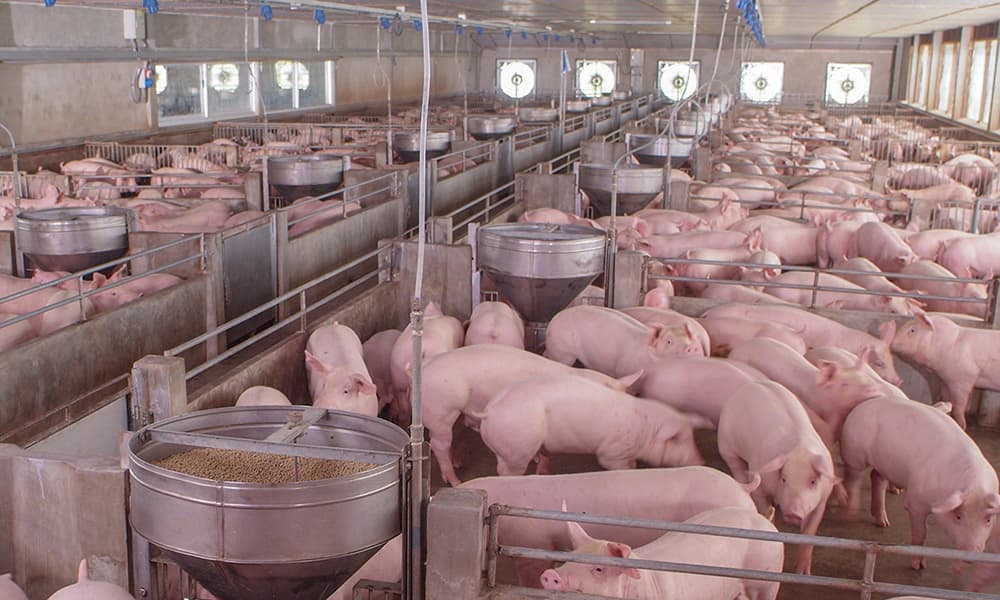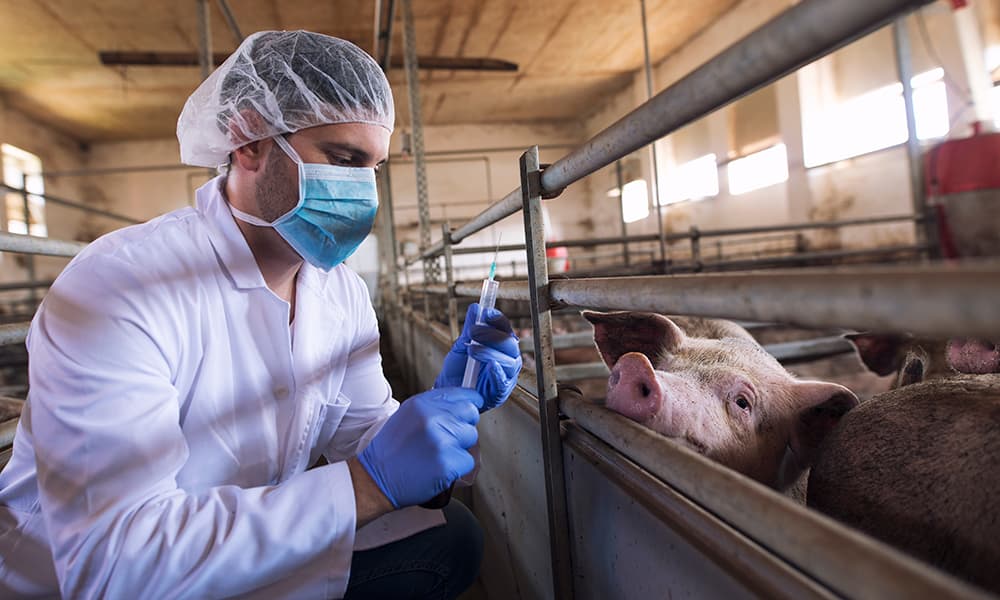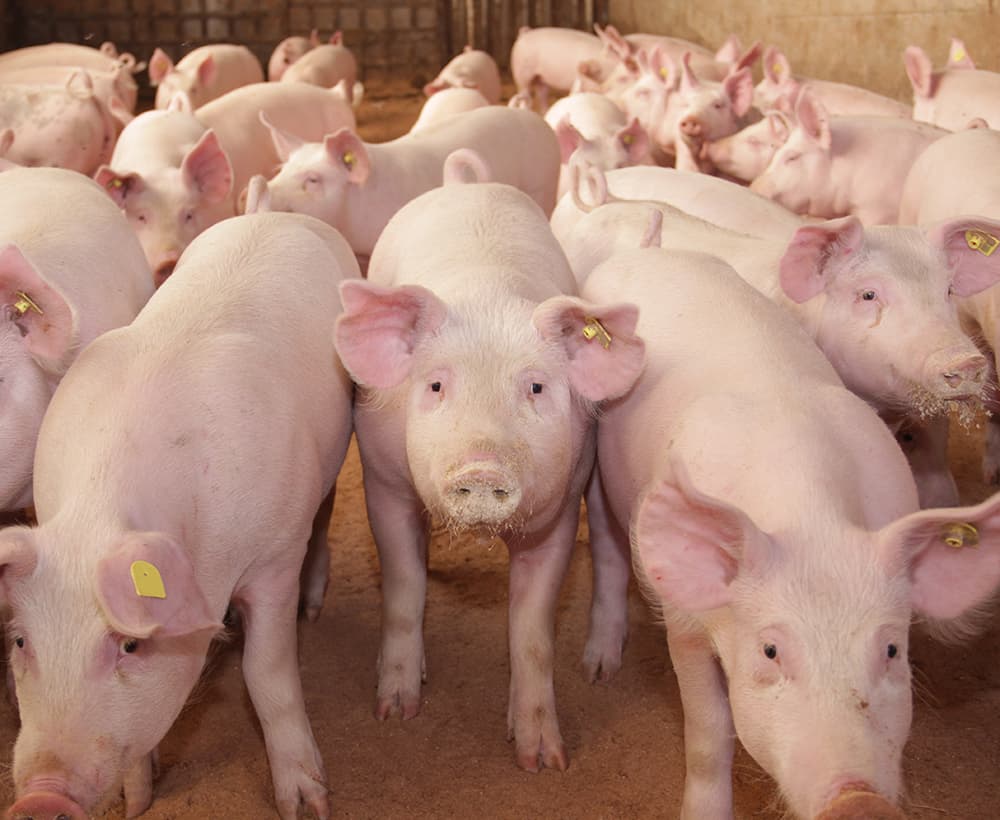Internal Biosecurity
Prevent the spread of diseases within your farm
Now that we know how to keep diseases from entering our farm, let us learn about what to do when the disease is already present inside the farm. This is what constitutes internal biosecurity, which we will learn through this module.
- Check herd regularly for overall health and have a veterinarian routinely test for prevalent infectious diseases
- Keep animals up to date on available vaccines after consulting a veterinarian, especially sows
- NOTE: Ideally, the rule of thumb is “one needle, one animal” which is not always feasible; change needles between sows and use a single needle per pen, litter, or group if possible
- Isolate sick animals and give them immediate treatment to contain disease quickly
- Report any unusual disease signs or symptoms to a veterinarian
Animal Movement/Pig Flow
Mixing animals from different age groups and stocks can risk the health of susceptible animals, so it is important to implement controlled animal movement and strict pig flow. All-in-all-out (AIAO) pig flow provides the highest internal biosecurity. It breaks the transmission cycle of diseases from one group to another, unlike continuous flow, where new additions bear the disease burden of the animals already present.
AIAO Protocol:
- Purchase animals or farrow them in groups that appropriately fit the facility and contain them in a specific facility
- NOTE: Do not mix purchased and far-born animals; purchase all animals from a single source
- When animals in a group are ready for market, move all of them out at the same time
- NOTE: Do not hold back and mix runts/tail-enders, but if they are held back, keep them at a separate facility away from the next group
- After the group has moved out, remove the bedding (if any) then clean the facility with warm water using a pressure hose to remove all dirt and manure from cracks, crevices, feeders, walls, ceiling, water troughs, penning, and flooring; use steam cleaner wherever possible for efficient cleaning
- After cleaning, disinfect the facility with a suitable disinfectant solution.
- Allow two weeks between cleaning the facility and moving a new group into it.
- For hoop-houses, spread a layer of agricultural limestone or ag-lime before placing fresh bedding
NOTE: Pigs always move in groups in the AIAO system
Dead Pig Disposal
Care must be taken in disposing of dead pigs and any other animal tissue like afterbirth. This is considered biohazardous waste, which can be controlled using the following protocol.
- Dispose of dead pigs and afterbirth at a place inaccessible to wild animals, birds, and insects
- Thoroughly clean and disinfect the area and equipment contaminated with biohazardous waste
- If biohazardous waste is disposed of on-site, do it as quickly as possible and in a bio-secure manner
- If the farm utilizes a pickup service for biohazardous waste, place it in a covered disposal bin outside the farm premises and ensure that the path of the service truck does not coincide with that of other farm vehicles to avoid cross-contamination
- Designate an area outside of farm premises if post-mortem examination needs to be performed
- Personnel handling biohazardous waste must change, clean, and disinfect boots and coveralls and shower before re-entering the farm
Manure Disposal
Manure acts as an effective carrier for numerous pathogens. Therefore, it is important for any farm to have a manure disposal plan to avoid manure piling within pens.
- In the outdoor rearing system, ensure water troughs, water bowls, and feed troughs are clean and free from manure contamination
- Do not use the same equipment for handling manure and feed
- Maintain separate equipment for each barn if possible
- If manual removal is required, do it routinely to avoid piling
- If manure storage bins are used, they should be covered and inaccessible to pigs, wild animals, birds, and insects
- If a lagoon is used, ensure that the pipe used to carry the manure is rodent proof to prevent the rodent from entering the building
- Plan manure disposal in a way that young animals do not have contact with manure from adult animals
- In the pasture rearing system, if the slurry is spread onto fields or pasture, keep pigs off the land for at least three weeks
- If professional haulers/manure pick-up services are used, place manure in a covered disposal bin outside the farm premises
- Keep path of haulers/pick-up service truck separate from other farm vehicles
- Thoroughly clean and disinfect the area and equipment contaminated with manure
- Personnel handling manure must change, clean, and disinfect boots and coveralls and shower before re-entering the farm premises
Intelligent building design can help minimize disease transmission by restricting the movement of animals of different age groups between sections. Keep design in mind when constructing new facilities or altering existing structures.
- New arrivals must not come in contact with existing stock
- In an old building, use physical barriers like gates, fences, and rails to keep new and existing stock separated
- Use good quality materials, tools, and equipment to avoid frequent repairs
- Animal housing facilities must be properly secured to prevent entry of other animals and unauthorized people
- Each facility must have its own room to store equipment, tools, coveralls, and boots that are not mixed with those of other facilities
- If equipment is shared between facilities, clean and disinfect them properly before using
- If the same coveralls are used between different facilities, move from a high-susceptible herd to low susceptible (e.g., from nursery pen to finishers pen, from healthy to sick animals, from existing stock to new isolated stock)
- Set up a boot bath at every facility entrance
- Regularly check and replace control measures for pests, rodents, birds, and other wildlife at every facility
- Check the building walls and floors for holes and repair as necessary to prevent rodents nesting
- Keep building interior and surrounding area clean, free from the trash that might attract the unwanted wildlife
- Mow surrounding area regularly to avoid excessive weed or grass growth
- Check building for water clogging or standing water

For Open Housing System
- Inspect rails and fences must be inspected regularly for damages and repaired immediately
- Replace wet bedding should be immediately
- Ensure that straw used for bedding did not come in contact with any other livestock animal
- Purchase straw for bedding from a source that assures animal contact-free production and transport of bedding material
All farm facilities including pens, changing room, equipment storage room, and office spaces must be routinely cleaned and disinfected to maintain a pathogen-free environment. The same measures apply to equipment and vehicles used for routine farm operations to avoid disease transmission.
- Clean and disinfect machinery, equipment, vehicles, and anything else that has been outside farm premises or shared with other farms before re-entering the farm
- Check new purchases (consumable or permanent) and deliveries for damage
- Disinfect incoming items before they enter the farm
- Wash coveralls in hot water and detergent after use
- Safely discard disposables (gloves, shoe covers, gowns) in a biohazard container
- Clean used boots using a pressure hose or boot scrub to remove visible dirt from its surface and then disinfect using a boot bath
Boot Bath Protocol
- Change disinfecting solution frequently (at least once a day/based on foot traffic in the farm
- Use a disinfecting solution that is strong and requires less contact time (e.g., 1% Virkon® S)
- Boots must be free from any visible dirt before entering the boot bath
- If the boot bath is contaminated with dirt or manure, change the solution immediately
- Stand in the boot bath for a minimum of one minute
Air Filtration
A good majority of infectious diseases are transmitted through the air. The most significant one is Porcine Reproductive and Respiratory Disease Syndrome (PRRS). Airborne infections are difficult to control. Installing air filters (especially High Efficiency Particulate Absorbing (HEPA) filters) in the barn can effectively control such pathogens. Even though this is an excellent biosecurity measure, it is expensive. Not every farm needs an air filter. This is mostly recommended for farms located in high swine density areas, commercial or stud/breeder farms, or farms with a high risk of PRRS infection.
- Establish an effective communication system, especially on farms with a lot of employees, such as through regular farm employees’ meetings
- Ensure personnel understand disease risk and transmission routes in their work environment and the importance of biosecurity in maintaining their own and farm animal health and well-being
- Take strict actions when personnel fail to follow biosecurity protocols
- Do not hire employees who own livestock animals or live at another livestock farm
General Biosecurity Protocols
- Do not move back and forth between barns or between different age groups of animals
- Keep movement unidirectional – from young to old animals, from healthy to sick animals
- Visit new incoming animals last
- Do not visit susceptible animals after visiting sick animals, but if this is necessary, change boots and coveralls after visiting sick animals
- Do not touch animals when not required
- Only eat in areas designated for eating; do not eat, drink, or carry food inside animal housing area
- Do not come to work if feeling sick, especially with flu-like symptoms
- Learn about animal behavior to identify sick animals
- Enter the farm either through shower-in-shower out facility if available or after cleaning and disinfecting hands and then changing into farm-specific boots and coveralls
- Do not move back and forth between clean and dirty areas without changing boots and coveralls
- Clean and disinfect boots and coveralls when contaminated with manure or other organic waste
- Do not wear farm-specific clothing and boots outside the farm premises
- Maintain personal hygiene and wash hands periodically
- Report to the employer immediately if you find unusual signs or symptoms in animals or if you find any breach in the farm biosecurity
What’s Next?
Internal biosecurity is important for all types of farms be it an All-in All-out system or the one that adds replacements like sow farms as if the disease is inside a farm, it is important to prevent its spread to healthy animals. Adopt and train your employees for these practices to minimize loss due to sick pigs to your production.


